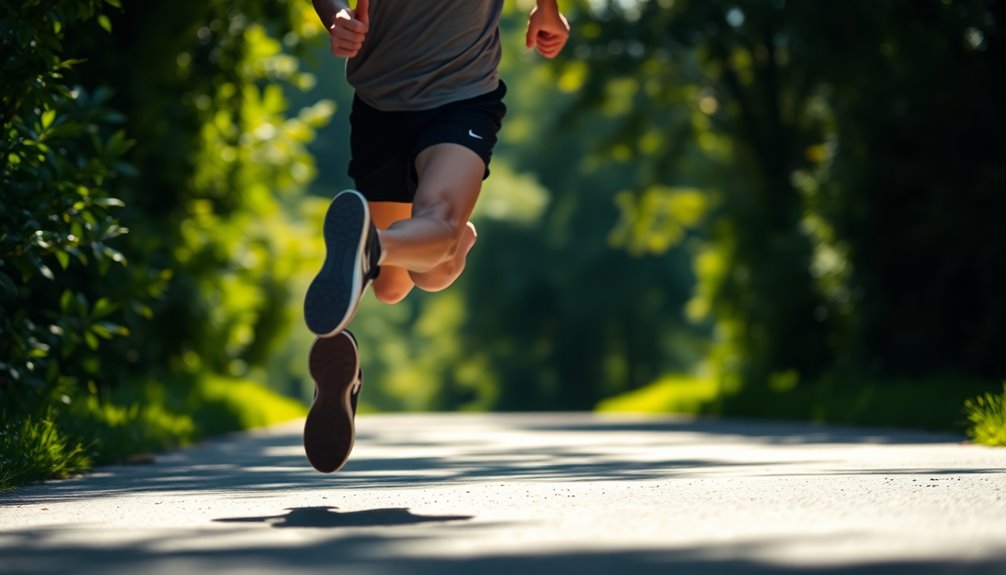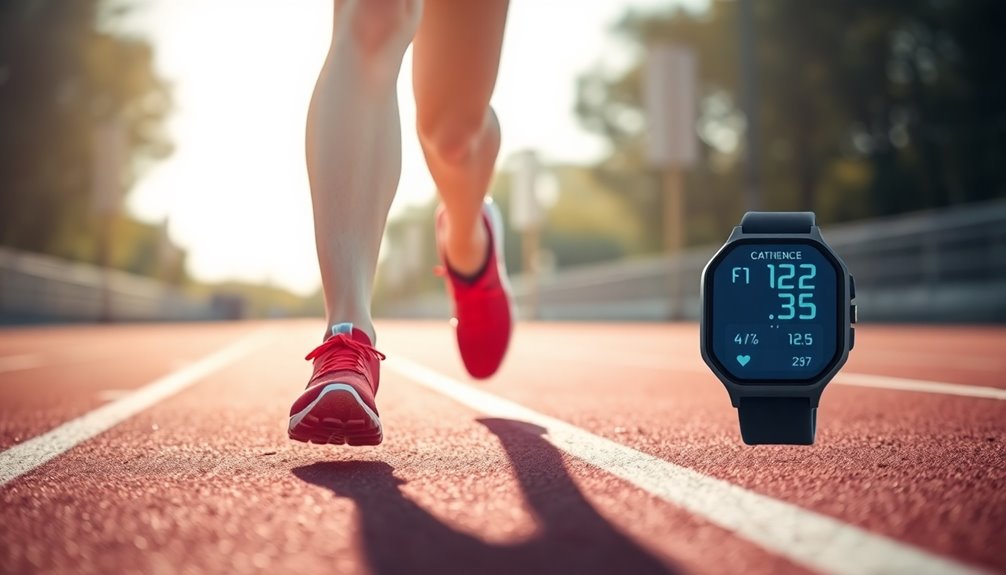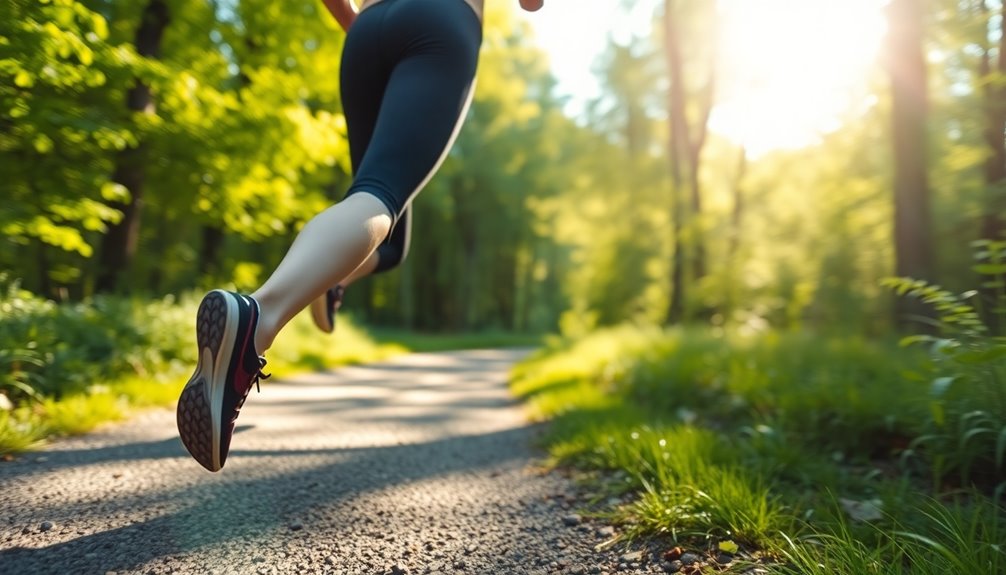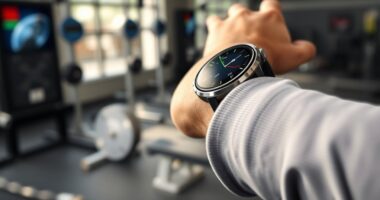To improve your cadence and running efficiency, start by aiming for around 160 to 180 steps per minute. You can use a metronome to help increase your stride rate by 5%. Incorporate drills like jump rope or downhill running accelerations to enhance foot speed. Strength training focused on jumps will also promote quicker strides. Monitoring your cadence often during your runs will help you adjust techniques. There's plenty more you can discover to elevate your running performance.
Key Takeaways
- Use a metronome app to gradually increase your cadence by 5% and establish a consistent rhythm during runs.
- Incorporate jump rope drills to enhance coordination and foot speed, which contributes to a quicker cadence.
- Practice downhill running accelerations to utilize gravity for achieving a faster step rate and improving overall cadence.
- Monitor your cadence every 7-10 minutes to make real-time adjustments and ensure alignment with your running speed.
- Focus on maintaining light and quick footfalls, emphasizing midfoot or forefoot strikes for better running mechanics.
Understanding Running Cadence

When you think about improving your running performance, understanding running cadence is essential.
Running cadence refers to the number of steps you take per minute (SPM). While average recreational runners typically run at 150 to 170 SPM, elite runners often maintain a higher cadence of 180 to 200 SPM.
Finding your ideal cadence can enhance running efficiency, as a higher cadence reduces overstriding and impact forces on your joints, helping to reduce injury risk.
To increase your cadence, consider adjusting it by just 5-10%, which can greatly boost your performance.
You can measure your cadence using running watches or mobile apps, allowing you to track your progress and refine your running mechanics for better results. Additionally, understanding color accuracy can help you choose the right projector for analyzing your running form using video playback.
Measuring Your Running Cadence

Measuring your running cadence is essential for enhancing your performance. To do this, count the number of steps you take in one minute, or track right foot strikes for 15 seconds and multiply by four to get your steps per minute (SPM).
Utilizing a GPS running watch can provide real-time cadence data, making it easier to monitor your efficiency during runs. Aim for a cadence around 180 steps per minute, but remember individual factors like height and running style can affect this.
Regularly check your cadence every 7-10 minutes to identify trends and adjust your techniques as needed. Apps like Strava and Runkeeper can also help you track your cadence and pinpoint areas for improvement. Additionally, improving your running efficiency can be aided by incorporating advanced sensors that help optimize your form and reduce energy expenditure.
Benefits of Increasing Cadence

Increasing your running cadence can notably enhance your overall performance and efficiency. By increasing your cadence, you'll likely experience improved running economy, allowing you to use less energy at higher speeds. This is essential for boosting your performance.
A higher cadence reduces impact forces on your joints, minimizing the risk of injuries linked to overstriding and excessive ground contact time. Research shows that a 5-10% increase in cadence considerably lowers musculoskeletal stress, providing better shock absorption during your runs.
Aiming for around 180 steps per minute, a benchmark of elite runners, can enhance your running efficiency. Improved cadence also encourages a midfoot or forefoot strike pattern, promoting better running form and further reducing injury likelihood with shorter ground contact times. Additionally, maintaining high vibrational energy during workouts can support your overall performance and encourage consistent improvement over time. Moreover, adopting a higher cadence can lead to greater aerobic capacity, a crucial element for endurance athletes. For instance, a 60-year-old runner’s incredible VO2 max is often a testament to how effectively they can utilize oxygen during their runs, showcasing the impact of training techniques that emphasize cadence and efficiency. By focusing on these aspects, you not only enhance performance but also set the stage for a sustainable and enjoyable running journey as you age.
Drills to Enhance Cadence

To boost your running efficiency, incorporating specific drills can make a significant difference in your cadence. Start with metronome training, gradually increasing your steps per minute by 5% to enhance quick foot turnover. After easy runs, implement running strides, aiming for 180 steps per minute. Jump rope drills are fantastic for building coordination and foot speed.
Additionally, perform downhill running accelerations, allowing gravity to assist in achieving quicker cadence. Include strength training with one-leg and two-leg jump exercises to promote a quicker stride rate. It's also beneficial to understand the emotional stress that can affect physical performance, similar to how it influences pregnancy cravings.
| Drill Type | Focus |
|---|---|
| Metronome Training | Steps per minute |
| Jump Rope Drills | Coordination & foot speed |
| Downhill Running | Natural cadence increase |
| Strength Training | Explosiveness & strength |
Integrating Cadence Improvement Into Your Runs

While integrating cadence improvement into your runs, it's essential to focus on small, manageable adjustments that fit seamlessly into your routine.
Start by aiming to improve your running cadence by gradually increasing your steps per minute, targeting a baseline of around 160 steps. Incorporate cadence drills like running strides or using a metronome app to reinforce a faster cadence.
Regularly monitor your cadence every 7-10 minutes to track your progress and guarantee your cadence aligns with your running speed. Focus on maintaining a light and quick footfall to enhance your running mechanics.
Don't forget to experiment with uphill running, as it naturally encourages a quicker step rate, ultimately boosting your overall running efficiency. Additionally, consider incorporating educational toys into your routine, as they can enhance cognitive development and improve focus during training sessions.
Frequently Asked Questions
How Can I Improve My Running Cadence?
To improve your running cadence, start by gradually increasing your steps per minute. Aim for a 5-10% boost over several weeks.
Use metronome apps or music to help maintain your target cadence, beginning around 160 steps per minute. Incorporate stride drills to enhance foot turnover and reduce ground contact time.
Regularly track your cadence every 7-10 minutes during runs, and try running downhill or jump rope drills to naturally increase your leg speed.
How Do I Get Better at Cadence?
Imagine you're running a 10K and notice your cadence feels sluggish.
To get better at cadence, start by gradually increasing your steps per minute by about 5-10% each week.
Try incorporating metronome training or using music that matches your target cadence.
Also, finish your easy runs with quick strides to practice light, rapid steps.
Engaging in jump rope drills can boost your foot speed, making your running feel more efficient.
What Is the Most Efficient Cadence for Running?
The most efficient cadence for running typically falls between 160 and 180 steps per minute.
While elite athletes might reach 180-200 SPM during intense efforts, you should find a cadence that feels comfortable and sustainable for you.
Factors like your height, leg length, and running terrain affect your ideal cadence, so it's important to listen to your body.
Gradually increasing your cadence can enhance your running efficiency and help prevent injuries.
How Can I Increase My Cadence Without Increasing Power?
You might find that increasing your cadence without upping your power feels like a dance, where rhythm is key.
Focus on shortening your stride and landing directly beneath you; this will promote quicker turnover.
Try rhythm drills with a metronome set between 170-185 beats per minute, and gradually boost your cadence by 5%.
Keep your upper body relaxed and engage in jump rope drills to enhance foot speed and coordination effortlessly.
Conclusion
As you lace up your shoes and step onto the open trail, envision each stride becoming lighter, more rhythmic. With every beat of your heart, you'll feel the flow of energy coursing through you, propelling you forward. Embracing these techniques will transform your runs into a dance of efficiency and grace, where the ground feels like a springboard. So, keep your focus on your cadence, and watch as the world blurs by in a beautiful, effortless rhythm.









